January 2003 (Part 1)
SELECTION OF QUESTIONS AND ANSWERS
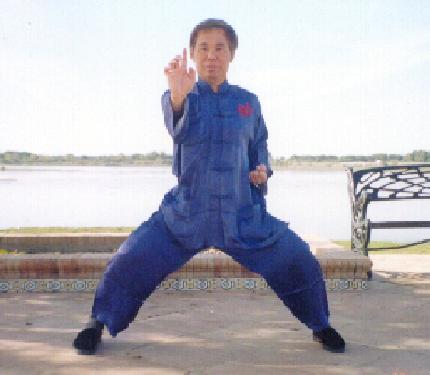
Sifu Wong demonstrating “One-Finger Shooting Zen”, which is a fundamental force training method in Shaolin Wahnam. Force training is essential in kungfu as a martial art.
Question 1
Can you please help us to understand the subtle distinctions of both the Confucian and Buddhist natures of the Shaolin Temple's Discipleship ceremony and monastic order, and can you explain in detail the ceremony you participated in, such as the series of vows taken? I would further be delighted to know if the tradition you are transmitting now is still part of a formal Buddhist lineage? What is the ceremony like for your disciples?
— Arhat, USA
Answer
Seeking to learn from my master, Sifu Ho Fatt Nam, was difficult, but once he agreed to accept me as his student, it was simple. There was no ceremony of discipleship or of monastic order. After all, I was not seeking to be a monk, I just wanted to learn Shaolin Kungfu. There were also no vows taken. My sifu just told me to attend class. It was as simple as that.
It was the same with my other masters. They accepted me as their student without rituals or formalities.
I am sorry I do not know the subtle distinctions between Confucian and Buddhist natures in initiation ceremonies and monastic orders. You would have to ask Confucian priests and Buddhist monks, though I suspect that real monks, especially Zen monks, would not be bothered with such trifles.
Similarly, in our school we are not fussy over rituals, though we are particular about good manners. For example, students do not call their teachers by names, but address them as sifus. Hence, whether our tradition is part of a formal Buddhist lineage, is irrelevant. Many of our students are believers of other religions, and we respect their feelings and traditions.
Nevertheless, there was an invaluable, and for me a deeply transformational though gradual process of personal development connected to my attending class at my sifu's house, which I would like to share with you. At the altar of the main hall were many statues of Buddhas, Bodhisattvas as well as Taoist gods. I was not only surprised, but actually quite disturbed. I clearly remember I thought to myself then, I come here to learn kungfu, not religion; I would have nothing to do with these gods and Bodhisattvas.
In my ignorance and arrogance, I did not even offer a joss stick at the altar. I considered that superstitious. Interestingly, years ago when I trained with Uncle Righteousness, I was the one responsible for tidying the altar and offering joss sticks to our First Patriarch, the Venerable Chee Seen. But at that earlier time — I was only a boy then — I considered the act a novice's routine, not an expression of gratitude and devotion, which it was meant to be.
Gradually my attitude changed. Direct personal experience which occurred during my training period with Sifu Ho Fatt Nam convinced me that if I was honest and claimed to be scientific, I just had to accept gods and Bodhisattvas exist. Now I feel it a privilege and honour to pray to them in private or in public.
Question 2
What does distant chi transmission actually accomplish? What does it do? How is it measurable? Where is the newspaper article?
Answer
Distant chi transmission accomplishes and does different things for different people in different situations. In my case I mainly use it to save lives. Its success or failure is measured by how well or badly it meets its purpose.
For example, if a recipient still lives after distant chi transmission, although according to conventional medical opinion he was supposed to die, I would rightly consider that distant chi transmission has been successful.
Most people, understandably, may not accept my conclusion. Some may attribute his recovery to placebo effect, some to luck, some to natural remission or to any other things except the most logical and most rational answer.
I did a public experiment on distant chi transmission in February 1989 in Malaysia. The experiment involving public members and its successful results were reported in all major English language and Chinese language newspapers in the country.
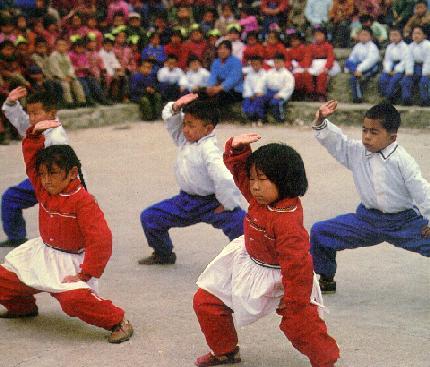
Wushu demonstration by a group of children. This picture is reproduced from a book entitled “Shaolin Kungfu” and in the book the caption of the picture is “Children demonstrating Shaolin Kungfu”.
Question 3
I have read your response to a questioner asking about a million dollar challenge of the Randi Organization. I understand you hold the belief that the agency's sole purpose is to discredit you. I believe rather that their sole purpose is to prove what is true, under scientific conditions which both parties must agree to.
Answer
I am sorry you have misunderstood me. I did not say that the main purpose of the Randi Organization was to discredit me or anyone who responded to their challenge. It is just that at the moment I am not ready, and not interested to take up the challenge.
Question 4
Of all your abilities, it seems strange that the distant chi transmission would be the one thing tested scientifically, via participation of an independent newspaper. I have looked earnestly for the results of this test and these efforts have proven fruitless. Can you provide us the details of this test? What qualified the newspaper as a scientific body? Can you provide us with further insight into what made you choose distant chi transmission as a testable claim and not something more immediate?
Answer
You have misunderstood me again. The distant chi transmission was never intended to be tested scientifically in the way you interpret it. There were, for example, no formal hypothesis, no quantitative measurements and no elaborate mathematical equations.
However, we believe it was scientific in spirit. The newspaper, though not a scientific body, was independent, and the recipients of chi were chosen by them from public volunteers. The experiment was carried out over a month, and witnessed by the public.
Distant chi transmission was not chosen from a list of alternatives. It was a response to a request from a major Chinese language newspaper in Malaysia.

Shaolin monks in combat. This double-page picture is reproduced from another book, also entitled “Shaolin Kungfu”, which purports to show the fantastic Shaolin Kungfu practiced by monks in the Shaolin Temple today.
Question 5
The great Ving Tsun master Moy Yat was a unique teacher within the Yip Man lineage. He understood Chan philosophy and strove to teach purely from a Chan perspective. He recognized a difference between the concepts of “person” and “science”.
It is said that he fully understood that “person” and “personality” represent “style”, while “system orientation” addresses “science”. True to his Chan roots and beliefs, he attempted at all times to separate himself and his personal preferences from the system as it was taught to him. In view of this context of such a master, would you say that the impression you have of Western scientific bodies seeking to test the claims of qigong practice is a personal preference?
Answer
Different groups, different peoples and different cultures view reality from different perspectives and using different paradigms. The view of Western scientific bodies seeking to test any claims is not a personal preference, it is a preference of a special professional group.
My view is also not a personal preference. It is the view of another professional group, that of chi kung (qigong) masters. The two different groups may address and see the same thing, but their language used and the view derived will be different.
The Zen (Cham) perspective is that of Mahayana Buddhism, which recognizes three types of wisdom, namely language wisdom, illuminated wisdom and cosmic wisdom.
Language wisdom is what we obtain from language, written and non-written. What you understand about Sifu Moy Yat's philosophy is language wisdom. Language wisdom is limited by the inability of words to convey exactly what the speaker or writer may want to convey, and what the listener or reader may interpret. For example, your concept of “style” and “science” may be very different from what Sifu Moy Yat meant them to be.
Illuminated wisdom is what we obtain from direct experience, defiled by our given sets of conditions. Suppose Sifu Moy Yat applied his philosophy to Wing Choon Kungfu, and you too do the same thing.
Sifu Moy Yat separated his “style” from his “science”. His “style' involved factors from his “person” and his “personality”, such as his age and size, and his feelings towards his students. His “science” expressed “system orientation” such as how a Wing Choon exponent would respond in a given combat situation. Hence, irrespective of how big he or his opponent was, and irrespective of whether he was calm or angry, he would use the same Wing Choon response to a given combat situation.
You do the same thing, and what you experience, including what you understand from this experience, constitutes your illuminated wisdom. But, although you and Sifu Moy Yat did the same thing, your illuminated wisdom will be different from Sifu Moy Yat's illuminated wisdom, because your conditions are different from Sifu Moy Yat's conditions. For example, Sifu Moy Yat was a Wing Choon master, but you presumably are not. So, using the same Wing Choon defence irrespective of the size of the opponent may not work for you, but it would work for Sifu Moy Yat.
Cosmic wisdom is also obtained from direct experience, but is transcendental. Suppose while performing your kungfu forms, or while walking along a stream leisurely, it suddenly flashes across your mind that what applies to Wing Choon Kungfu can also apply to Shaolin Kungfu, or to any other things. You suddenly realize that what is wrong and impossible for you may be right and possible for another person, or for you in a different situation. This is cosmic wisdom, though it is at a very low, mundane level.
These three divisions of wisdom are meant for better understanding of reality; they are not mutually exclusive. For example, “person”, “personality”, “style”, “system orientation” and “science” may be language wisdom or illuminated wisdom, and on some rare occasions may be cosmic wisdom.
Question 6
I have been told you view the process as if you were doing the testing body a favour. If we look at this in contrast to the greater good of humanity, who would greatly benefit if the claims of qigong practice were proven once and for all to be true results of qigong practice, it seems that personal preference is being favoured over the greater, scientific good. If the special ability claims are true, what should it matter if they are tested scientifically?
Answer
As mentioned above, different groups have different perspectives. My perspective is that of traditional masters, who regarded their arts as secrets, passed on only to selected disciples. It is diametrically different from a popular New Age concept believing that a master should share his art freely and openly to save the world.
Nevertheless, my own education has been Western, and I am much influenced by Western ideals which I admire and respect. In many ways I am handing out secrets freely and openly. Almost any Tom, Dick and Harry can join my regional classes where they may experience results in a few hours that others may take a few years to attain via orthodox ways!
Understandably, my revolutionary methods of teaching traditional arts have caused different reactions. Traditional masters are unhappy with me, bogus instructors are angry at my exposition, the uninformed call me a fraud, and the irresponsible say the arts can be performed by their girlfriends and mothers. I would not want further complications from scientific agencies which usually view things in their own ways.
But if any agencies, scientific, medical or otherwise, wish to explore the possibilities of my arts for their own or the world's benefit, and are prepared to drop provincial prejudice, I would be glad to co-operate. But they would have to approach me, not I them.
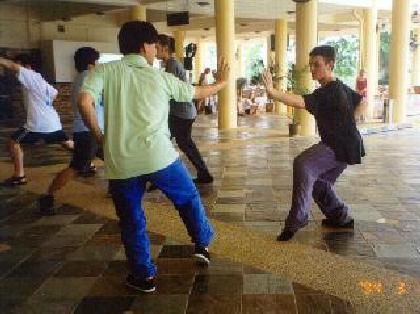
Combat training is an essential part of Shaolin Kungfu. Here Tai Chee Yong from Malaysia and Ronan Sexton from England, two of Sifu Wong's inner-chamber disciples, assessed each other before moving in for combat in an Intensive Shaolin Kungfu Course in Malaysia in March 2002.
Question 7
As of yet, no such special ability claim has withstood scientific scrutiny to an acceptable level. I am curious to know why this is, since it seems so prevalent. If they are real, they will stand. Do you ever see yourself changing your mind about submitting to a Randi Organization test? What would the agency or scientific body have to do to alleviate your misgivings about participating in such a test? In fact, you would be integral to the construction of the test.
Answer
There have been many special abilities that have withstood scientific scrutiny, only that you are unaware of them, or that you and some scientific agencies use different models for acceptance.
One distinguished modern example is the great chi kung master Yan Xin. His experiments were tested under strict scientific conditions at Qing Hua University, probably the most prestigious university in China, under the supervision of Professor Chen Xue Xin, the father of Chinese rocket.
There has been a lot of other research elsewhere. But no scientific or medical authorities seem to be interested in them. The reason is certainly not due to a lack of research on the matter. If these agencies are interested they can find a lot of research papers written on them. Indeed, I believe a main reason why these papers are not brought to public notice is because scientific agencies could not find any faults in them.
In this respect I proposed a simple and effective research procedure at the International Congress for the Unity of Science in Seoul in 2000, where some of the world's best scientists gathered. Briefly my proposal is as follows.
Get a group of, say, 100 persons suffering from a so-called incurable disease, such as diabetes. This group will be selected by an independent body from representative sections of a population. Get a similar group to act as a control group. Measure the two groups according to standard medical parameters.
Get a world recognized chi kung master to teach chi kung to the research group for a year. Measure the two groups after every three months as well as at the end of the year according to standard medical parameters. Work out quantitatively how well or badly chi kung has helped the research group to overcome the disease.
As I expected, no scientific agencies took up the proposal.
Question 8
As you are aware, several of your students or disciples participate in online discussion forums. Very often, these students speak on your behalf. In one such exchange, a questioner did not get along with some of your students, and after an ensuing barrage of insults from both sides, was told he could not train with you. This person earnestly wishes to learn from you. Would you accept or dismiss him as a potential student?"
Answer
I would say your comment “barrage of insults from both sides” is not fair. I followed the discussions in our Wahnam forum, and some of the discussions in the Russbo and the Cyberkwoon forums, and I am proud to say that despite being insulted and verbally abused, all my students and disciples in the forums replied courteously and honestly.
Indeed, by merely looking at the style of the author, without looking at the content, one can readily tell which side he is on. The style also reveals much about the author, telling for example whether he is confident or uncertain, responsible or merely playing the fool. The content of my students' and disciples' answers was also excellent, following closely the teaching of our school.
This person you mentioned also insulted my family, illustrating with my family photograph. I may tolerate insult to myself repeatedly, but I may not tolerate insult to my family. In fact, manifesting the warrior's spirit of my Shaolin training, I sought legal advice to take action against him, but some of my disciples (including those whom he had insulted) spoke on his behalf. I am proud of their attitude. We could trace who this person was and where he lived. I am sure that if not for our Shaolin teaching of tolerance, some of them might have gone to his house to punch him.
My disciples were right to say that I would not accept him as my student, not because of his different opinions in the discussions but because he could not qualify. The most important requirement for acceptance is to follow our Ten Shaolin Laws, and the first law requires students to respect the master. Repeatedly nsulting the master and his family is certainly disrespectful.
Nevertheless, this person has spoken kindly about me recently. If he changes his attitude and becomes respectful, and is sincere in wanting to learn from me, I may consider when he applies.
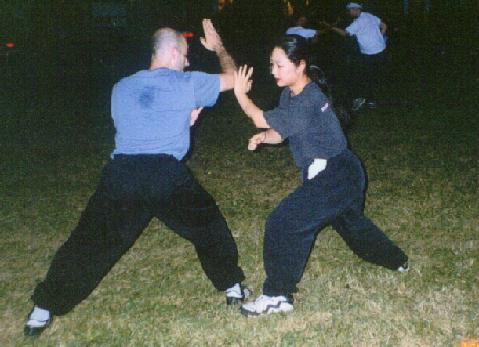
Another two of Sifu Wong's inner-chamber disciples, Anthony Korahais from the United States and Emiko Hsuen from Canada, practice sparring during a regional Shaolin Kungfu Course in Toronto in July 2002. Emiko has just intercepted Anthony's horizontal sweep, "Sweeping a Thousand Armies", and is about to turn from her Horse-Riding Stance into a Bow-Arrow Stance to drive a leopard punch into Anthony's ribs. Good stances are crucial in kungfu sparring, failing which Emiko would not be successful in intercepting Anthony's powerful sweep.
Question 9
In light of the recent exchange between the students and disciples of Ven. Shi Yan Ming, and your students and disciples regarding the Yi Jin Jing, it was clear that the mutual understanding of the two groups was that the Yi Jin Jing was a set of physical exercises. However there was major disagreement over the concept of the word “Jing”. and the confusion that word and its multiple contextual meanings might engender, between the usage as “sutra” or “classic”. I was wondering if you could express some further thoughts on this matter.
Answer
I followed the lively discussion on Yi Jin Jing in the Russbo forum. Anthony, who has the advantage of knowing Chinese, which makes a huge difference, gave some splendid answers, which also express the views of our school.
Here I would reproduce briefly what Anthony has said in the Russbo forum, then mention a few other points.
Obviously, choosing to call the Yi Jin Jing a sutra can cause confusion, as it has in this instance. Most scholars translate Yi Jin Jing as “Sinew Metamorphosis” in order to avoid such confusion. The Yi Jin Jing is a set of Chi Kung exercises. A sutra is a recorded teaching of the Buddha. This is calling a spade a spade.
There are many methods to attain a spiritual “awakening” and cultivate towards enlightenment. Practicing the exercises from the Yi Jin Jing is one method. Practicing sitting meditation is another method. Reciting sutras, worshipping Bhodisattvas, or solving koans are other methods. These methods are called “fang bian” in Chinese, which translates roughly to “expedient means.”
The argument presented by Bhodi and Arhat is, in essence, that the Yi Jin Jing can be viewed as an “expedient means” for attaining an awakening or even enlightenment. I agree with this statement. However, calling it an expedient means is significantly different than calling it a sutra.
However, it is also said that Da Mo found the monks too weak for the rigors of vigorous sitting meditation. He therefore taught them Lo Han Shi Ba Shou (Eighteen Lohan Hands) and Yi Jin Jing (Sinew Metamorphosis). The Yi Jin Jing was therefore used as an “expedient means.”
Given this historical background, I hope it will become clearer why calling the Yi Jin Jing a sutra makes things unnecessarily confusing. These intellectual gymnastics confuse the matter rather than simplifying it. Some people like to call a spade a rose, but I like to call a spade a spade and a rose a rose. Life is simpler this way.
In our school, and as far as I know in all other schools except yours, Yi Jin Jing is understood and practiced as a set of chi kung exercise, though many schools practice it as physical exercise. The crucial difference between physical exercise and chi kung exercise is that the former works on the physical body, like joints and muscles, whereas the latter works on energy.
Anthony, who was already powerful, participated in my Yi Jin Jing class in Toronto recently. After a training session I made it a point to ask the class if they felt any internal force. Everybody said yes. Anthony said he felt he could chop down a tree.
Internal force is not just for martial arts. It is for anything where energy is needed. It is particularly useful for spiritual cultivation. In another recent Yi Jin Jing class in Brighton organized by Dan, the tremendous force purged out some negative karmic effects in Victor. You can read about it in Victor's own words in the Shaolin Wahnam Virtual Kwoon and Discussion Forum.
It is reasonable if you practice Yi Jin Jing as physical exercise or read it as a sutra, and have never been exposed to what we call “high level chi kung”, that you may think our claims as fraudulent, and that our students (many of whom are highly respected people like national presidents, state ministers, corporate leaders, leading doctors and top scientists) “would crawl if the master asked them to crawl”.
You are entitled to keep your views, but we really feel pitiful that you and some others who are sincere in wanting to know more about Yi Jin Jing and presumably understand that the onus of Zen or Chan teaching is on practical experience, choose to miss this opportunity to experience the tremendous practical benefits of Yi Jin Jing offered so near to your house. You may not have a similar opportunity again.
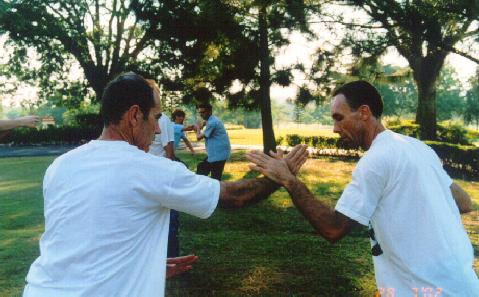
Sparring practice is essential in all styles of kungfu. At the Special Taijiquan Course in July 2002 in Malaysia, two of Sifu Wong's inner-chamber disciples, Inaki Rivero Urdiain from Spain and Roberto Lemberti from Italy applied Taijiquan skills and techniques in combat.
Question 10
Between Wing Choon and Praying Mantis, which one is more practical and will defeat an opponent without wasting much time?
— Jason, Australia
Answer
As in many other questions, there is no absolute answer. It depends on a few variables, like your abilities, needs and resources. For example, for a woman wearing a tight skirt, or a man confined to his office room, Wing Choon is more practical, because Praying Mantis involves much leg stretching and jumping. But if I am fighting in open space and the opponent is attacking me with kicks and throws, I would prefer Praying Mantis.
If all other things were equal, a Wing Choon exponent would defeat his opponent without wasting much time, as Wing Choon Kungfu is noted for its economy of movement. This does not mean Wing Choon Kungfu is a more effective fighting art than Praying Mantis Kungfu, because the assumption of the Wing Choon exponent defeating his opponent may not be valid. If the opponent avoids the attack and counters with continuous kicks, if all other things were equal, it would be easier for him to defeat a Wing Choon exponent than a Praying Mantis exponent., because there are more defence techniques against kicks in Praying Mantis than in Wing Choon Kungfu.
The examples given above are only theoretical, assuming that all other things were equal, and the only thing not equal is the issue in question. In real life, almost all things are not equal. For example, even if you were wearing a tight skirt or confined to your office room, Praying Mantis will be more practical for you if you have learnt it from a master, whereas your learning of Wing Choon Kungfu is from a book. Although he may use more movements, a Praying Mantis exponent can defeat an opponent faster than a Wing Choon exponent does, if the former is more skilful. Similarly a skilful Wing Choon exponent can more effectively defend against continuous kicks than a less skilful Praying Mantis exponent, even when the latter knows more defence techniques.
Question 11
I live in a small city where there are not any very good instructors who teach martial arts. In my kungfu school, which is the only one that teaches wushu in my city, we never really spar. We do mostly forms and drills. Do you think this is the proper way to learn kungfu and learn how to defend myself?
— Jeff, Canada
Answer
There has been quite a lot of confusion between kungfu and wushu, and the main reasons are as follows. In the Chinese language, the current technical term for martial art is “wushu”, although many Chinese, especially overseas Chinese, colloquially call it “kungfu”, which is also the term commonly used in the West.
Secondly, since the 1970s, the Chinese government has promoted wushu as a sport and not a martial art. Today there are many wushu teachers, Chinese as well as non-Chinese, teaching this sport all over the world.
Thirdly, some kungfu schools which have existed outside China before modern wushu was invented in China, now also teach modern wushu besides traditional kungfu. The standard of traditional kungfu in these schools is generally low, usually without training in internal force or sparring. In essence, in these schools there is not much difference between “kungfu” and “wushu”. The difference is in appearance, and is easily noticeable. By “kungfu” they usually mean traditional kungfu forms, by “wushu” they mean modern forms invented since 1970s.
Apart from these three points, there is another aspect which is more subtle or subjective, and can be quite sensitive. To me, kungfu is a martial art. So, if someone practices traditional kungfu forms, as distinct from modern wushu forms, but does not know how to use his art for combat, I would not call it kungfu. This is a minority opinion. The majority still call it “kungfu” even if it is devoid of any martial application.
Sometimes I use the term “genuine kungfu” or “real kungfu” to differentiate kungfu that is capable of combat application from “kungfu” that is devoid of combat application. I also use terms like “external kungfu forms” or “kungfu gymnastics” to refer to the latter. These terms are not ideal and sometimes cause resentment but I could not think of better terms.
This background information explained above, can help to overcome much confusion and help to solve many arguments over kungfu and wushu. For example, one person may argue that all kungfu is wushu, and another person may vehemently oppose. Both persons are right from their own different pers;pectives. The first person argues from the perspective that the Chinese word for kungfu is “wushu”, whereas the second person argues from the perspective that kungfu is a martial art but wushu is a sport.
Reversely, one person may argue that what he practices is kungfu, whereas another may argue that it is wushu. The first person argues from the perspective that his forms are traditional, whereas the second argues that although the forms are different in appearance from modern wushu forms, they are practiced not as a martial art but as a sport and therefore in essence is modern wushu.
Today many schools only practice forms and drills, and never spar — irrespective of whether they teach only traditional kungfu forms, or only modern wushu forms, or both traditional kungfu and modern wushu forms together. This is the norm.
Those schools that teach only traditional kungfu forms, as well as those that teach both traditional kungfu and modern wusshu forms are usually called kungfu schools, whereas those that teach modern wushu forms are usually called wushu schools — if we refer to them in English.
If we refer to them in Chinese, all of them are usually called “wushu” schools, including those that practice traditional kungfu forms, and even if they use genuine kungfu for sparring. This is the de-facto situation, and sometimes causes confusion. My school, for example, is “Shaolin Wahnam Kungfu Institute” in English, but “Shao Lin Hua Nan Wu Shu Guan” (Cantonese: “Siu Lam Wah Nam Mo Shert Kwoon”) in Chinese.
If you mostly practice forms and drills, no matter how long you may practice them and how beautiful your solo performance may be, and irrespective of whether they are traditional kungfu forms and drills or modern wushu forms and drills, you will not be able to defend yourself if you have never learnt sparring methodically. Although this is the norm, in my opinion it is certainly not the correct way to learn kungfu (as a martial art) and learn how to defend yourself.
Anyone, master or novice, who has never learnt to spar, will be unable to spar or fight effectively. This is only logical. This is as logical as anyone who has never learnt how to speak Spanish (although he may know the meanings of written Spanish words) will be unable to speak Spanish, or anyone who has never learnt how to drive a car (although he may have read many driving manuals) will be unable to drive a car.
